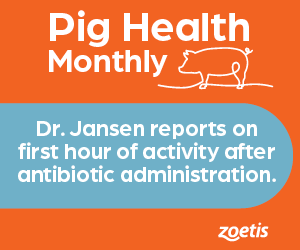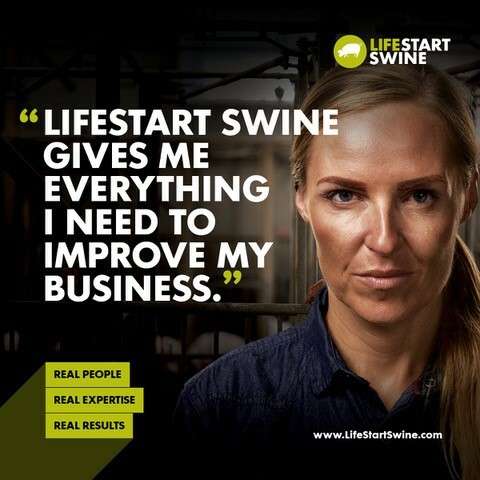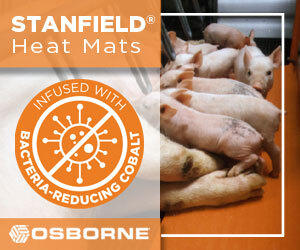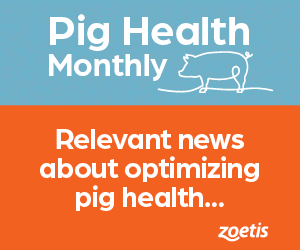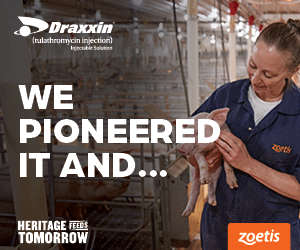



The Effects of Climate Change on Livestock Production
J.L. Hatfield of USDA's Agricultural Service (ARS) explains the influences of climate on livestock.Climatic Influences on Livestock
Climate changes, as suggested by some GCMs, could impact the economic viability of livestock production systems worldwide. Surrounding environmental conditions directly affect mechanisms and rates of heat gain or loss by all animals (NRC 1981). Lack of prior conditioning to weather events most often results in catastrophic losses in the domestic livestock industry. In the central U.S. in 1992, 1995, 1997, 1999, 2005, and 2006, some feedlots (intensive cattle feeding operations) lost in excess of 100 head each during severe heat episodes. The heat waves of 1995 and 1999 were particularly severe with documented cattle losses in individual states approaching 5,000 head each year (Hahn and Mader 1997; Hahn et al. 2001). The intensity and/or duration of the 2005 and 2006 heat waves were just as severe as the 1995 and 1999 heat waves, although the extent of losses could not be adequately documented.
The winter of 1996-97 also caused hardship for cattle producers because of greater than normal snowfall and wind velocity, with some feedlots reporting losses in excess of 1,000 head. During that winter, up to 50 percent of the newborn calves were lost, and more than 100,000 head of cattle died in the Northern Plains of the United States.
Additional snowstorm losses were incurred with the collapse of and/or loss of power to buildings that housed confined domestic livestock. Early snowstorms in 1992 and 1997 resulted in the loss of more than 30,000 head of feedlot cattle each year in the southern plains of the United States (Mader 2003).
Economic losses from reduced cattle performance (morbidity) likely exceed those associated with cattle death losses by several-fold (Mader 2003). In addition to losses in the 1990s, conditions during the winter of 2000-2001 resulted in decreased efficiencies of feedlot cattle in terms of overall gain and daily gain of approximately 5 and 10 percent, respectively, from previous years as a result of late autumn and early winter moisture, combined with prolonged cold stress conditions (Mader 2003). In addition, the 2006 snowstorms, which occurred in the southern plains around year end, appear to be as devastating as the 1992 and 1997 storms. These documented examples of how climate can impact livestock production illustrate the potential for more drastic consequences of increased variability in weather patterns, and extreme events that may be associated with climate change.
Potential Impact of Climate Change on Livestock
The risk potential associated with livestock production systems due to global warming can be characterized by levels of vulnerability, as influenced by animal performance and environmental parameters (Hahn 1995). When combined performance level and environmental influences create a low level of vulnerability, there is little risk. As performance levels (e.g., rate of gain, milk production per day, eggs/day) increase, the vulnerability of the animal increases and, when coupled with an adverse environment, the animal is at greater risk. Combining an adverse environment with high performance pushes the level of vulnerability and consequent risk to even higher levels. Inherent genetic characteristics or management scenarios that limit the animal’s ability to adapt to or cope with environmental factors also puts the animal at risk. At very high performance levels, any environment other than near-optimal may increase animal vulnerability and risk.
The potential impacts of climatic change on overall performance of domestic animals can be determined using defined relationships between climatic conditions and voluntary feed intake, climatological data, and GCM output. Because ingestion of feed is directly related to heat production, any change in voluntary feed intake and/or energy density of the diet will change the amount of heat produced by the animal (Mader et al. 1999b). Ambient temperature has the greatest influence on voluntary feed intake. However, individual animals exposed to the same ambient temperature will not exhibit the same reduction in voluntary feed intake. Body weight, body condition, and level of production affect the magnitude of voluntary feed intake and ambient temperature at which changes in voluntary feed intake begin to be observed. Intake of digestible nutrients is most often the limiting factor in animal production. Animals generally prioritize available nutrients to support maintenance needs first, followed by growth or milk production, and then reproduction.
Based on predicted climate outputs from GCM scenarios, production and response models for growing confined swine and beef cattle, and milk-producing dairy cattle have been developed (Frank et al. 2001). The goal in the development of these models was to utilize climate projections – primarily average daily temperature – to generate an estimate of direct climate-induced changes in daily voluntary feed intake and subsequent performance during summer in the central portion of the United States (the dominant livestock producing region of the country), and across the entire country. The production response models were run for one current (pre-1986 as baseline) and two future climate scenarios: doubled CO2 (~2040) and a triple of CO2 (~2090) levels. This data base employed the output from two GCMs – the Canadian Global Coupled (CGC) Model, Version I, and the United Kingdom Meteorological Office/Hadley Center for Climate Prediction and Research model – for input to the livestock production/ response models. Changes in production of swine and beef cattle data were represented by the number of days to reach the target weight under each climate scenario and time period. Dairy production is reported in kilograms of milk produced per cow per season. Details of this analysis are reported by Frank (2001) and Frank et al. (2001).
In the central US (MINK region = Missouri, Iowa, Nebraska, and Kansas), days-to-slaughter weight for swine associated with the CGC 2040 scenario increased an average of 3.7 days from the baseline of 61.2 days. Potential losses under this scenario averaged 6 percent and would cost swine producers in the region $12.4 million annually. Losses associated with the Hadley scenario are less severe. Increased time-to-slaughter weight averaged 1.5 days, or 2.5 percent, and would cost producers $5 million annually. For confined beef cattle reared in the central U.S., time-to-slaughter weight associated with the CGC 2040 scenario increased 4.8 days (above the 127-day baseline value) or 3.8 percent, costing producers $43.9 million annually. Climate changes predicted by the Hadley model resulted in loss of 2.8 days of production, or 2.2 percent. For dairy, the projected CGC 2040 climate scenario would result in a 2.2 percent (105.7 kg/cow) reduction in milk output, and cost producers $28 million annually. Production losses associated with the Hadley scenarios would average 2.9 percent and cost producers $37 million annually. Figures 2.12, 2.13, and 2.14 indicate predicted changes in productivity in swine, beef and dairy, respectively, for the various regions of the United States.
Across the entire United States, percent increase in days to market for swine and beef, and the percent decrease in dairy milk production for the 2040 scenario, averaged 1.2 percent, 2.0 percent, and 2.2 percent, respectively, using the CGC model, and 0.9 percent, 0.7 percent, and 2.1 percent, respectively, using the Hadley model. For the 2090 scenario, respective changes averaged 13.1 percent, 6.9 percent, and 6.0 percent using the CGC model, and 4.3 percent, 3.4 percent, and 3.9 percent using the Hadley model. In general, greater declines in productivity are found with the CGC model than with the Hadley model. Swine and beef production were affected most in the south-central and southeastern United States. Dairy production was affected the most in the US Midwest and Northeast regions.
 |
|
Figure 2.12 Percent change from baseline to 2040 of days for swine to grow from 50 to 110 kg, beginning June 1 under CGC (bold text) and Hadley (italicized text) modeled climate (Frank 2001; Frank et al. 2001)
|
 |
|
Figure 2.13 Numerical values represent changes in beef productivity based on the number of days required to reach finish weights from baseline to 2040, beginning June 1 under CGC (bold text) and Hadley (italicized text) modeled climate (Frank 2001; Frank et al. 2001)
|
 |
|
Figure 2.14 Percent change of kg fat-corrected milk (FCM) yield/cow/ season (June 1 to October 31) from baseline to 2040, under CGC (bold text) and Hadley (italicized text) modeled climate (Frank 2001; Frank et al. 2001)
|
In earlier research, Hahn et al. (1992) also derived estimates of the effects of climate change of swine growth rate and dairy milk production during summer, as well as other periods during the year. In the east-central United States, per animal milk production was found to decline 388 kg (~4 percent) for a July through April production cycle, and 219 kg (~2.2 percent) for an October through July production cycle as a result of global warming. Swine growth rate in this same region was found to decline 26 percent during the summer months, but increased nearly 12 percent during the winter months as a result of global warming. Approximately one-half of these summer domestic livestock production declines are offset by improvements in productivity during the winter. In addition, high producing animals will most likely be affected to a greater extent by global climate change than animals with lower production levels.
A production area in which global climate change may have negative effects that are not offset by positive winter effects is conception rates, particularly in instances when the breeding season primarily occurs in the spring and summer months. (This will particularly affect cattle.)
Hahn (1995) reported that conception rates in dairy cows were reduced 4.6 percent for each unit change when the THI reaches above 70. Amundson et al. (2005) reported a decrease in pregnancy rates of Bos taurus cattle of 3.2 percent for each increase in average THI above 70, and a decrease of 3.5 percent for each increase in average temperature above 23.4°C. These data were obtained from beef cows in a range or pasture management system. Amundson et al. (2006) also reported that of the environmental variables studied, minimum temperature had the greatest influence on the percent of cows getting pregnant. Clearly, increases in temperature and/ or humidity have the potential to affect conception rates of domestic animals not adapted to those conditions. Summertime conception rates are considerably lower in the Gulf States compared with conception rates in the Northern Plains (Sprott et al. 2001).
In an effort to maintain optimum levels of production, climate change will likely result in livestock producers selecting breeds and breed types that have genetically adapted to conditions that are similar to those associated with the climate change. However, in warmer climates, breeds that are found to be more heat tolerant are generally those that have lower productivity levels, which is likely the mechanism by which they were able to survive as a dominant regional breed. In addition, climate change and associated variation in weather patterns will likely result in more livestock being managed in or near facilities that have capabilities for imposing microclimate modifications (Mader et al. 1997a, 1999a; Gaughan et al. 2002). Domestic livestock, in general, can cope with or adapt to gradual changes in environmental conditions; however, rapid changes in environmental conditions or extended periods of exposure to extreme conditions drastically reduce productivity and are potentially life threatening.
Estimates of livestock production efficiency suggest that negative effects of hotter weather in summer outweigh positive effects of warmer winters (Adams et al. 1999). The largest change occurred under a 5°C increase in temperature, when livestock yields fell by 10 percent in cow-calf and dairy operations in Appalachia, the Southeast, Mississippi Delta, and southern Plains regions of the United States. The smallest change was one percent under 1.5°C warming in the same regions.
Another area of concern is the influence of climate change on diseases and parasites that affect domestic animals. Incidences of disease, such as bovine respiratory disease, are known to be increasing (Duff and Gaylean 2007). However, causes for this increase can be attributed to a number of non-environmentally related factors. As for parasites, similar insect migration and over-wintering scenarios observed in cropping systems may be found for some parasites that affect livestock.
Baylis and Githeko (2006) describe the potential of how climate change could affect parasites and pathogens, disease hosts, and disease vectors for domestic livestock. The potential clearly exists for increased rate of development of pathogens and parasites due to spring arriving earlier and warmer winters that allow greater proliferation and survivability of these organisms. For example, bluetongue was recently reported in Europe for the first time in 20 years (Baylis and Githeko 2006). Warming and changes in rainfall distribution may lead to changes in spatial or temporal distributions of those diseases sensitive to moisture such as anthrax, blackleg, haemorrhagic septicaemia, and vector-borne diseases.
However, these diseases, as shown by climatedriven models designed for Africa, may decline in some areas and spread to others (Baylis and Githeko 2006).
Animal Production Systems
Increases in air temperature reduce livestock production during the summer season with partial offsets during the winter season. Current management systems usually do not provide as much shelter to buffer the effects of adverse weather for ruminants as for non-ruminants. From that perspective, environmental management for ruminants exposed to global warming needs to consider: 1) general increase in temperature levels, 2) increases in nighttime temperatures, and 3) increases in the occurrence of extreme events (e.g., hotter daily maximum temperature and more/longer heat waves).
In terms of environmental management needed to address global climate change, the impacts can be reduced by recognizing the adaptive ability of the animals and by proactive application of appropriate countermeasures (sunshades, evaporative cooling by direct wetting or in conjunction with mechanical ventilation, etc.). Specifically, the capabilities of livestock managers to cope with these effects are quite likely to keep up with the projected rates of change in global temperature and related climatic factors. However, coping will entail costs such as application of environmental modification techniques, use of more suitably adapted animals, or even shifting animal populations.
Climate changes affect certain parasites and pathogens, which could result in adverse effects on host animals. Interactions exist among temperature, humidity, and other environmental factors which, in turn, influence energy exchange. Indices or measures that reflect these interactions remain ill-defined, but research to improve them is underway. Factors other than thermal (i.e., dust, pathogens, facilities, contact surfaces, technical applications) also need better definition. Duration and intensity of potential stressors are of concern with respect to the coping and/or adaptive capabilities of an animal. Further, exposure to one type of stressor may lead to altered resistance to other types. Other interactions may exist, such that animals stressed by heat or cold may be less able to cope with other stressors (restraint, social mixing, transport, etc). Improved stressor characterization is needed to provide a basis for refinement of sensors providing input to control systems. Innovations in electronic system capabilities will undoubtedly continue to be exploited for the betterment of livestock environments with improved economic utilization of environmental measures, and mitigation strategies. There is much potential for application of improved sensors, expert systems, and electronic stockmanship. Continued progress should be closely tied to animal needs based on rational criteria, and must include further recognition of health criteria for animal caretakers as well. The ability of the animal’s target tissues to respond to disruptions in normal physiological circadian rhythms may be an important indicator of stress.
Also, the importance of obtaining multiple measures of stress is also becoming more apparent. However, inclusion and weighting of multiple factors (e.g. endocrine function, immune function, health status, vocalizations) is not an easy task in developing integrated stress measures. Establishing that may result in reduced performance or health are essential. Improved modeling of physiological systems as our knowledge base expands will help the integration process.
Further Reading
| - | You can view the full report by clicking here. |
June 2008








